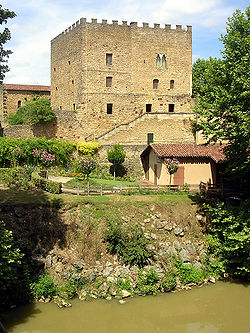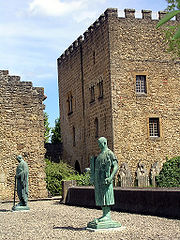
Donjon Lacataye
Encyclopedia

Keep
A keep is a type of fortified tower built within castles during the Middle Ages by European nobility. Scholars have debated the scope of the word keep, but usually consider it to refer to large towers in castles that were fortified residences, used as a refuge of last resort should the rest of the...
of a 14th century castle
Castle
A castle is a type of fortified structure built in Europe and the Middle East during the Middle Ages by European nobility. Scholars debate the scope of the word castle, but usually consider it to be the private fortified residence of a lord or noble...
, constructed by order of Gaston Phébus
Gaston III of Foix-Béarn
Gaston III/X of Foix-Béarn, also Gaston Fébus or Gaston Phoebus was the 11th count of Foix, and viscount of Béarn . Officially, he was Gaston III of Foix and Gaston X of Béarn.-Early life:...
in the commune
Communes of France
The commune is the lowest level of administrative division in the French Republic. French communes are roughly equivalent to incorporated municipalities or villages in the United States or Gemeinden in Germany...
of Mont-de-Marsan
Mont-de-Marsan
Mont-de-Marsan is a commune and capital of the Landes department in Aquitaine in southwestern France.Mont-de-Marsan airbase « Constantin Rozanoff » is a major installation of the French Air Force. The base includes CEAM , an air defense radar command reporting centre, and an air defence control...
in the Landes département of France. Today, it houses a museum.
History
La Cataye consists of two joined RomanesqueRomanesque architecture
Romanesque architecture is an architectural style of Medieval Europe characterised by semi-circular arches. There is no consensus for the beginning date of the Romanesque architecture, with proposals ranging from the 6th to the 10th century. It developed in the 12th century into the Gothic style,...
houses, which one sees perfectly while entering the current museum whose central internal wall includes Romanesque windows, a sign that one of the two houses was built before the second. These houses belonged to the Viscount's family and were more or less abandoned starting from the 15th century, when the Viscounts moved away from their town of origin. During the 16th century, their upper parts were modified and they were equipped with crenellations. The material used is coquillère, a local sedimentary rock
Sedimentary rock
Sedimentary rock are types of rock that are formed by the deposition of material at the Earth's surface and within bodies of water. Sedimentation is the collective name for processes that cause mineral and/or organic particles to settle and accumulate or minerals to precipitate from a solution....
.
The name Cataye comes from the Spanish verb “castar”, to supervise. It is entirely possible that these houses replaced a preceding mound structure with tower because the site is also called: “pujorin”, i.e. “pouy jorin” ( pouy : height and jorin , deformation of lorenh : towards the east).
In 1860, Antoine Lacaze, mayor and owner of the keep, gave it to the town to house troops. It later became the departmental barracks until 1875, when the soldiers moved to the Bosquet barracks
Pierre Bosquet
Pierre François Joseph Bosquet was a French Army general. He served during the conquest of Algeria and the Crimean War; returning from Crimea he was made Marshal of France and senator.-Biography:...
in the town. The keep preserved the name Caserne Lacaze (Lacaze Barracks) for nearly a century, in spite of a succession of civil uses: boarding school for young girls, gymnastics centre, municipal workshop.
The keep today

Charles Despiau
Charles Despiau was a French sculptor.Despiau was born at Mont-de-Marsan, Landes and attended first the Ecole des Arts Décoratifs and later the Ecole des Beaux Arts...
et Robert Wlérick.
It has been listed since 1942 as a monument historique
Monument historique
A monument historique is a National Heritage Site of France. It also refers to a state procedure in France by which national heritage protection is extended to a building or a specific part of a building, a collection of buildings, or gardens, bridges, and other structures, because of their...
by the French Ministry of Culture.

